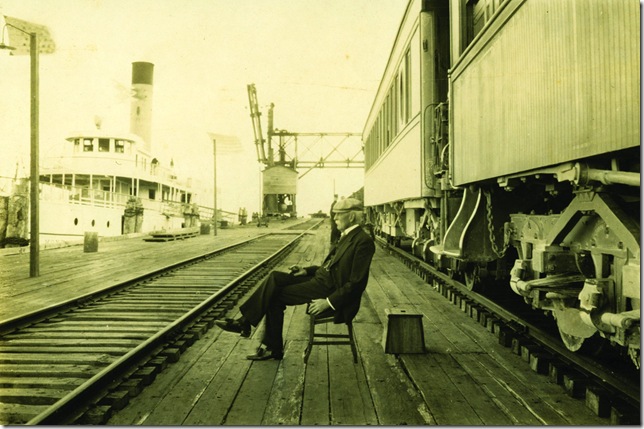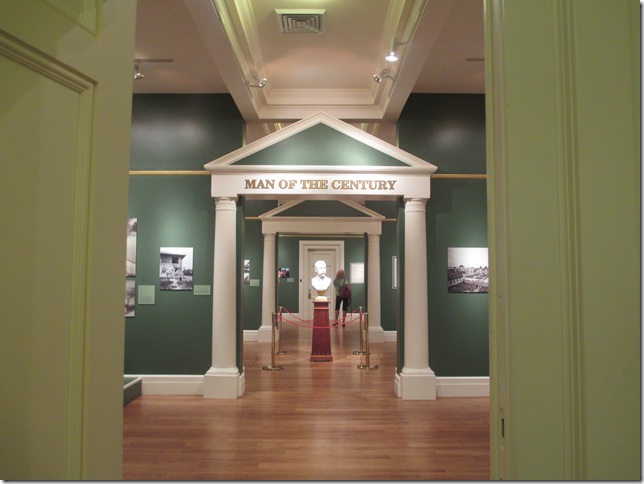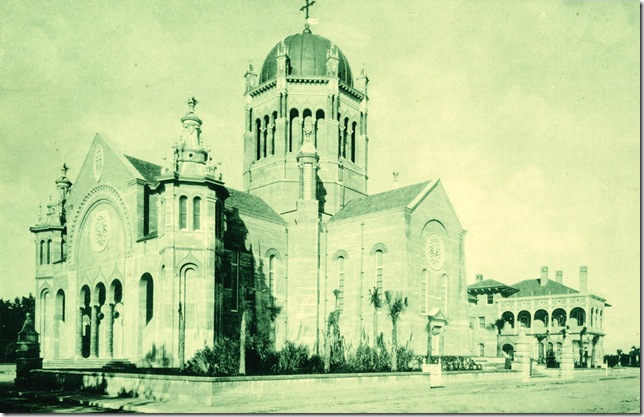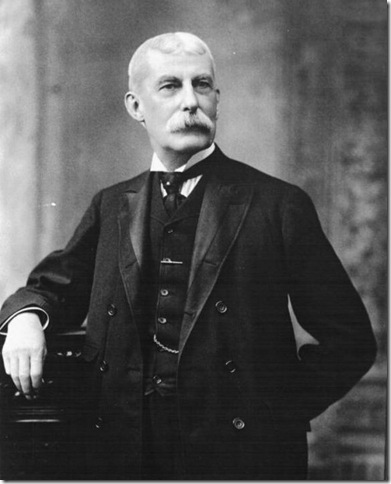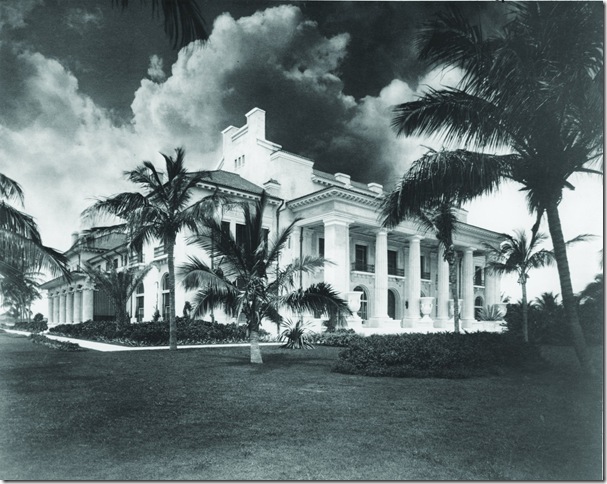The best part of writing about a man responsible for historic hotels, impossible railroads and that this state is now livable, is knowing he is remembered for the right reasons. In other words, I can skip the horseradish.
There is nothing phony or in need of polish when it comes to Henry Flagler. His legacy speaks for itself and is now the focus of an exhibit at the Flagler Museum commemorating the 100th anniversary of his death.
There he is, shaking the hand of Adm. Lucien Young at the opening celebrations for the Over-Sea Railroad on Jan. 22, 1912. He is 82 years old in this photo, an old man. Those of us who did not get to meet him can only stare at the blown-up print and imagine what it must have been to shake the hand of Flagler that day. I will have to settle for the white marble bust of him standing in the second room of the exhibit.
Man of the Century: The Incomparable Legacy of Henry Morrison Flagler dedicates three rooms of photographs, postcards, maps and documents to a man some knew as a genius businessman, generous host, visionary developer and philanthropist. There are plenty of panoramic snapshots as well as group photos. We see his crew of engineers, railroad workers, ladies having afternoon tea and guests attending a New Year’s Eve ball.
Included also are images related to Standard Oil (the highly profitable company Flagler co-founded with John D. Rockefeller and Samuel Andrews in 1870) and his Florida East Coast Steamship Co., which later became the Peninsula and Occidental Steamship Co. A postcard promoting Havana reads “the Paris of the Western Hemisphere.” At the time, a round trip to Havana cost $18.70 from Tampa and $20 from Orlando.
Several photographs of mangrove swamps and wild terrain on display are a reminder of what a pain this sunny state was at the time Flagler decided to build a bridge over bodies of water as long as seven miles. In one, a group of men with a friendly dog stands looking at the camera. They wear hats and hold pipes in their mouth. Near them hangs a Men Wanted Poster from 1906 that lists the wages: $1.50 per day. By the end, 142 bridges were built along the 128 miles of the Over-Sea Railroad.
Only occasionally do we come face to face with the protagonist of the exhibit.
We do see him riding a rickshaw in front of the Royal Poinciana Hotel, which to me is one of the highlights of the show, but a rare one. It is as if the museum staff had put together the exhibit in a way only Flagler would have approved of: letting his work do the talking.
A photo from 1896 shows the first hotel guests arriving by train at the Royal Poinciana, one of a series of luxurious hotels Flagler built in Florida to accommodate tourists and friends. Aerial photos illustrate the majestic presence of buildings like the Hotel Cordova, Hotel Alcazar and Hotel Ponce de Leon while interior photos show the details of dining rooms, courtyards and grand parlors.
Flagler did not shy away from extravagance but believed that it, too, should serve a higher purpose. Every structure he had built was an opportunity to bring art, history, literature and music together under one roof to be enjoyed by many in the present and in the future. With that in mind, he employed the best artists, musicians and decorators, such as Louis Comfort Tiffany and the New York firm Pottier & Stymus.
A blown-up print featuring the 1903 Bal Poudré at the Whitehall shows just how elegant the parties were. This famous social event, literally named powdered wig ball, usually took place around George Washington’s birthday. In 1903, Flagler and his wife, Mary Lily, hosted their first.
In the last room, near the silver-and-gold plaque Key West gave him in gratitude for the railroad, is a list of more than 35 companies Flagler founded or acquired throughout his life. By the time he died in 1913, his estate was worth around $100 million, which represents more than $12.5 billion today. His many enterprises and social engagements had rewarded him handsomely and so he gave back to the community. It seemed to him the natural thing to do.
The Yamato colony, a Japanese pineapple farming community near today Boca Raton, was established with the help of Flagler’s Florida East Coast Railway. So were the colonies for Swedish and Danish immigrants known today as Modello and Hallandale. In Miami, Flagler built and furnished a church for the Presbyterian congregation and after a 1887 fire destroyed St. Augustine’s Catholic Cathedral, he gave money to help pay for the bell tower.
In West Palm Beach, he donated the land for St. Ann’s Catholic Church (the first Catholic church in Palm Beach County) and for the Holy Trinity Episcopal Church (the second of its type in the Lake Worth area). He built studios for the artists he employed and during evening receptions guests could view and purchase their work.
A widely circulated “candid” photo of him from 1908, is here too. It is the first day of rail service to Knight’s Key dock and Flagler is sitting down. We see him from the side, alone, contemplative. If you have not come across it yet, this is the perfect context to see it in. You can detect a quietness only seen in a man with true achievements.
He is quoted with having said: “The desire to help others comes when a man has more than enough for his own needs. I have come to the conclusion that the best way to help others is to help them help themselves.”
I wonder what Henry Flagler would say about the billionaires of today.
MAN OF THE CENTURY is on view through Jan. 5 at the Flagler Museum. Regular ticket prices: Adults: $18; $10 for youth ages 13-17; $3 for children ages 6-12; and children under 6 admitted free. Hours: 10 am to 5 pm Tuesday through Saturday, noon to 5 pm Sunday. For more information, call 561-655-2833 or visit www.flaglermuseum.us.
***
As a further service to our readers, here is this review in Spanish:
Flagler: La cantidad exacta de riquezas y corazon
La mejor parte de escribir sobre un hombre responsable de hoteles historicos, ferrocarriles imposibles y que este estado sea habitable es saber que es recordado por las razones correctas. En otras palabras, me evito todas las imbecilidades.
No hay nada falso ni necesitado de barniz cuando se trata de Henry Flagler. Su legado habla por si solo y ahora es el foco de una exposicion en el museo Flagler que conmemora el aniversario 100 de su muerte.
Alli esta, dandole la mano al admirable Lucien Young el 22 de Enero de 1912, dia de la inauguracion del ferrocarril que cruzo el mar (Over-Sea Railroad). Tiene 82 años en esta foto; ya un hombre viejo. Aquellos de nosotros que no lo llegamos a conocer solo podemos mirar la imagen agrandada e imaginarnos como hubiese sido darle la mano a Flagler ese dia. Tendre que conformarme con su busto de marmol blanco que yace en la segunda sala de la exposicion.
Hombre del Milenio: El Incomparable Legado de Henry Morrison Flagler (Man of the Century: The Incomparable Legacy of Henry Morrison Flagler) dedica tress salas de fotografias, postales, mapas y documentos a un hombre que algunos conocieron como un genio en los negocios, visionario, huesped generoso y filántropo. Varias escenas panoramicas se encuentran como tambien fotos en grupo. Vemos su equipo de ingenieros, obreros del ferrocarril, señoras bebiendo el te del mediodia e invitados llegando a un baile de fin de año.
Incluidas tambien estan imagenes relacionadas con Standard Oil (la compania exitosa que Flagler fundo con John D. Rockefeller y Samuel Andrews en 1870) y su compañia Florida East Coast Steamship, la cual mas tarde se convirtio en Peninsula y Occidental Steamship Co. Una postal promoviendo la Habana dice “el Paris del Hemisferio Oeste.” En aquel tiempo el viaje de ida y vuelta a la Habana costaba $18.70 saliendo de Tampa y $20 desde Orlando.
Varias fotografias de pantanos y terrenos silvestres nos hacen recordar el dolor de cabeza que este estado soleado era en el momento que a Flagler se le ocurrio construir un puente que cruzara varios cuerpos de agua tan largos como siete millas. En una fotografia, un grupo de hombres aparecen de pie mirando a la camara acompañados por un perrito amistoso. Llevan sombreros y pipas en la boca. Cerca de ellos cuelga un anuncio del 1906 que dice “Men Wanted” (Se Buscan Hombres) por $1.50 al dia. Al final, 142 puentes se construyeron a lo largo de las 128 millas del Ferrocarril Sobre Mar (Over-Sea Railroad).
Solo en ocasiones entramos cara a cara con el protagonista de la exposicion.
Sí lo vemos montado en una calesa oriental al frente del hotel Royal Poinciana, lo cual para mi es uno de los puntos mas altos de la exposicion pero tambien de los raros. Es como si los representantes del museo la hubiesen organizado en una forma que solo Flagler hubiera aprobado: dejando que su trabajo hable por si solo.
Una foto del 1896 muestra los primeros invitados llegando al hotel Royal Poinciana en tren. El Poinciana es uno en la serie de hoteles lujosos que Flagler construyo en la Florida para acomodar a turistas y amistades. Fotos aereas ilustran la presencia majestuosa de edificios como el Hotel Cordova, Hotel Alcazar y el Hotel Ponce de Leon mientras que fotos de interiores muestran el detalle de los comedores, patios y grandes salones.
Flagler no se cohibia de la extravagancia pero creia que esta, tambien, debia de tener un proposito superior. Cada estructura que mando a hacer fue una oportunidad de agrupar el arte, la historia, la literatura y la musica bajo un mismo techo para que fueran disfrutadas en el presente y en el futuro. Con esa idea en mente contrato a los mejores artistas, musicos y decoradores. Entre ellos estaban Louis Comfort Tiffany y la firma newyorkina Pottier & Stymus.
Una imagen agrandada del Bal Poudré del 1903 en el Whitehall muestra justo cuan elegantes eran las fiestas. Este famoso evento social llamado literalmente baile de pelucas talqueadas tomaba lugar normalmente alrededor del cumpleanos de George Washington. En 1903, Flagler y su esposa, Mary Lily, hicieron su primer Bal Poudré.
En la ultima sala, cerca de la placa de plata y oro que Key West le dio en gratitud por el ferrocarril, yace una lista de mas de 35 compañias fundadas o acquiridas por Flagler al transcurso de su vida. Al morir, en 1913, su estado tenia un valor cerca de los $100 millones, lo cual hoy representa $12.5 billones. Sus negocios y participaciones sociales lo habian recompensado en gran manera asi que se dispuso a ayudar a la comunidad. Le parecia lo mas natural del mundo.
La colonia Yamato, una comunidad japonesa agricultora de piñas situada cerca de la actual Boca Raton, se establecio con la ayuda del Florida East Coast Railway, una compañia de Flagler. Tambien lo hicieron las colonias danesas y suecas conocidas hoy como Modello y Hallandale. En Miami, Flagler construyo y adorno una iglesia para la congregacion presbiteriana y dio dinero para ayudar a pagar el campanario luego de que un incendio destruyera la Cathedral Catolica de San Augustine en 1887. En West Palm Beach, dono el terreno para la Iglesia Catolica Santa Ann (la primera iglesia catolica en el condado Palm Beach) y para la Iglesia Episcopal de la Divina Trinidad (la segunda de su clase en el area de Lake Worth). Construyo talleres para los artistas que contrataba quienes vendian y exponian sus trabajos durante recepciones nocturnas.
Aqui tambien se encuentra una conmovedora, y ya gran circulada, fotografia de él tomada en 1908. Es el primer dia del servicio ferreo al Knight’s Key Dock y Flagler esta sentado. Lo vemos de perfil, solo, contemplativo. Si aun no la ha visto, este es el contexto perfecto para hacerlo. Se puede detectar la quietud y el silencio de un hombre de logros verdaderos.
Se le otorga con haber dicho: “El deseo de ayudar a otros llega cuando un hombre tiene mas que suficiente para sus propias necesidades. He llegado a la conclusion de que la mejor manera de ayudar a otros es ayudandolos a ayudarse ellos mismos.”
Me pregunto que diria Flagler de los billonarios de hoy en dia.
